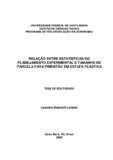| dc.creator | Lorentz, Leandro Homrich | |
| dc.date.accessioned | 2017-05-10 | |
| dc.date.available | 2017-05-10 | |
| dc.date.issued | 2008-11-28 | |
| dc.identifier.citation | LORENTZ, Leandro Homrich. Relationship among experimental planning statistics and chili pepper plot size in plastic greenhouse. 2008. 75 f. Tese (Doutorado em Agronomia) - Universidade Federal de Santa Maria, Santa Maria, 2008. | por |
| dc.identifier.uri | http://repositorio.ufsm.br/handle/1/3170 | |
| dc.description.abstract | The interior of a plastic greenhouse whose plants had been cultivated on soil
can be considered a heterogeneous environment due high variability in the
production, being necessary the use of experimental techniques for improvement of
the statistical inferences precision. Between the main forms of obtain experimental
error reduction is the use of the optimal plot size that has special importance in
experiments inside plastic greenhouse, where the experimental area is normally
restricted to the preexisting installations. Therefore, it is necessary to know the
optimal plot size (Xo) for the cultures as well as understanding the relations among
the parameters that determine it. The aim of this work is to estimate the relation of
the equations parameters that determine the optimal plot size and estimate the
optimal plot size for fruit fresh phytomass of chili pepper cultivated in plastic
greenhouse. It was conducted four blank experiments under plastic covering, each
one with ten culture lines of 70 plants. The fruit fresh phytomass was evaluated in
each plant, identifying its position inside the greenhouse, by the line number, and its
position in the line in each harvest. The optimal plot size was estimated and related
with the parameters used for its estimate by the Pearson correlation coefficient, the
path analysis and the response surface methodology. In the end of this work is
recommended the use of parcels with ten plants in the line and at least three
harvests for parcel. It was observed that Xo was negatively correlated with the
number of harvested plants and the average of each culture line in the harvests. The
positive and high correlation of the coefficient of variation estimate for the parcels of a
basic unit and Xo indicates that this is its main determinative one, reducing the
importance of the heterogeneity index (b), that if related weakly with Xo. | eng |
| dc.description.sponsorship | Coordenação de Aperfeiçoamento de Pessoal de Nível Superior | |
| dc.format | application/pdf | por |
| dc.language | por | por |
| dc.publisher | Universidade Federal de Santa Maria | por |
| dc.rights | Acesso Aberto | por |
| dc.subject | Capsicum annuum | por |
| dc.subject | Precisão experimental | por |
| dc.subject | Tamanho da
parcela | por |
| dc.subject | Ambiente protegido | por |
| dc.subject | Capsicum annuum | eng |
| dc.subject | Experimental precision | eng |
| dc.subject | Plot size | eng |
| dc.subject | Greenhouse | eng |
| dc.title | Relação entre estatísticas do planejamento experimental e tamanho de parcela para pimentão em estufa plástica | por |
| dc.title.alternative | Relationship among experimental planning statistics and chili pepper plot size in plastic greenhouse | eng |
| dc.type | Tese | por |
| dc.description.resumo | O interior de uma estufa cujas plantas foram cultivadas no solo pode ser
considerado um ambiente heterogêneo devido a grande variabilidade na produção,
sendo necessário o uso de técnicas experimentais para melhoria da precisão das
inferências estatísticas. Entre as principais formas de redução do erro experimental
está o uso do tamanho ótimo da parcela, que apresenta especial importância em
experimentos com estufa plástica, visto que a área experimental normalmente é
restrita às instalações preexistentes. Dessa forma, é importante conhecer o tamanho
ótimo de parcela (Xo) para as culturas bem como compreender as relações entre os
parâmetros que o determina. Sendo assim, os objetivos desse trabalho foram:
estimar a relação dos parâmetros das equações que determinam o tamanho ótimo
da parcela e estimar o tamanho ótimo para a fitomassa fresca de frutos de pimentão
cultivado em estufa plástica. Para isso, foram conduzidos quatro experimentos em
branco sob cobertura plástica, cada um com dez linhas de cultivo de 70 plantas.
Então, coletou-se em cada planta a fitomassa fresca dos frutos, identificando sua
posição dentro da estufa pelo número da linha e a sua posição dentro da linha em
cada colheita. Estimou-se o tamanho ótimo da parcela e relacionou-o com os
parâmetros usados para sua estimativa através do coeficiente de correlação de
Pearson, da análise de trilha e da metodologia de superfície de resposta. Ao fim
deste trabalho recomendou-se o uso de parcelas de dez plantas na linha e ao
menos três colheitas por parcela. Observou-se que Xo correlacionou-se
negativamente com o número de plantas colhidas e com a média obtida por linha de
cultivo nas colheitas. A correlação positiva e alta da estimativa do coeficiente de
variação para as parcelas de uma unidade básica e Xo indica que esta é sua
principal determinante, reduzindo a importância do índice de heterogeneidade do
solo (b), que se relacionou fracamente com Xo. | por |
| dc.contributor.advisor1 | Lúcio, Alessandro Dal'Col | |
| dc.contributor.advisor1Lattes | http://lattes.cnpq.br/0972869223145503 | por |
| dc.contributor.referee1 | Martin, Thomas Newton | |
| dc.contributor.referee1Lattes | http://lattes.cnpq.br/6293291442552572 | por |
| dc.contributor.referee2 | Cargnelutti Filho, Alberto | |
| dc.contributor.referee2Lattes | http://lattes.cnpq.br/0233728865094243 | por |
| dc.contributor.referee3 | Storck, Lindolfo | |
| dc.contributor.referee3Lattes | http://lattes.cnpq.br/7538496041313334 | por |
| dc.contributor.referee4 | Lopes, Sidinei José | |
| dc.contributor.referee4Lattes | http://lattes.cnpq.br/7533347017859354 | por |
| dc.creator.Lattes | http://lattes.cnpq.br/3133075693356442 | por |
| dc.publisher.country | BR | por |
| dc.publisher.department | Agronomia | por |
| dc.publisher.initials | UFSM | por |
| dc.publisher.program | Programa de Pós-Graduação em Agronomia | por |
| dc.subject.cnpq | CNPQ::CIENCIAS AGRARIAS::AGRONOMIA | por |


